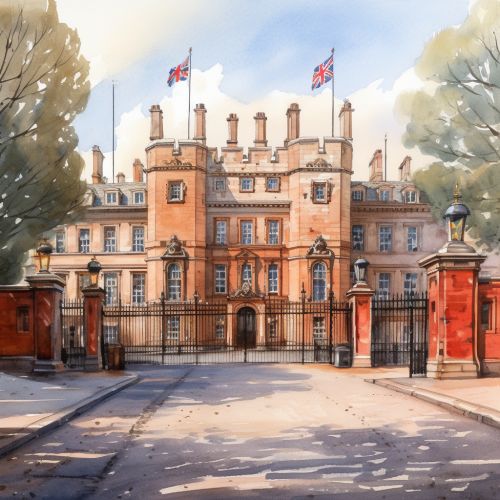St James's Palace
History
St James's Palace is one of the oldest royal palaces in the United Kingdom and is situated in the City of Westminster. Although the monarch no longer resides at the palace, it remains the ceremonial home of the British monarchy and is a key site for state occasions and royal hospitality.
The palace was commissioned by King Henry VIII, on the site of a former leper hospital dedicated to Saint James the Less, from which the palace and its nearby park take their names. The new palace was constructed between 1531 and 1536 as a smaller residence to escape formal court life. Much of the original red-brick building still stands today, including the Chapel Royal, the gatehouse, some turrets, and two surviving Tudor rooms.


In 1809, much of the palace was destroyed in a fire. However, the State rooms, used for official and state business, were spared. These rooms were renovated and remain in use today.
Architecture
The architecture of St James's Palace is predominantly Tudor, a style characterized by its four-centered arches, ornate carvings, and lofty towers. The palace's most recognizable feature is its gatehouse, an impressive structure that includes a clock tower. The gatehouse is one of the oldest parts of the palace and is still in use today.
The State Apartments, which include the Throne Room, the Tapestry Room, and the Queen's Chapel, are notable for their grandeur and historical significance. The Throne Room, adorned with intricate tapestries and ornate woodwork, is where the monarch receives distinguished guests. The Tapestry Room, named for its richly woven wall coverings, is used for formal receptions. The Queen's Chapel, a place of worship for the royal family, is a masterpiece of classical architecture.
Role and Functions
St James's Palace has been the setting for some of the most significant events in British royal history. It was the birthplace of King Charles II and King James II and was a residence for kings and queens for over 300 years.
Today, the palace is not a residence for the monarch, a role it has not played since Queen Victoria moved to Buckingham Palace in 1837. However, it remains a working palace and hosts numerous royal functions and events. The offices of the Royal Collection Trust, the Marshal of the Diplomatic Corps, and several other royal organizations are located at St James's Palace.
The palace is also the meeting place for the Accession Council, a body that proclaims the new sovereign upon the death of a monarch. Furthermore, foreign ambassadors and high commissioners to the UK are formally accredited to the Court of St James's, a term used to denote the monarchy.
